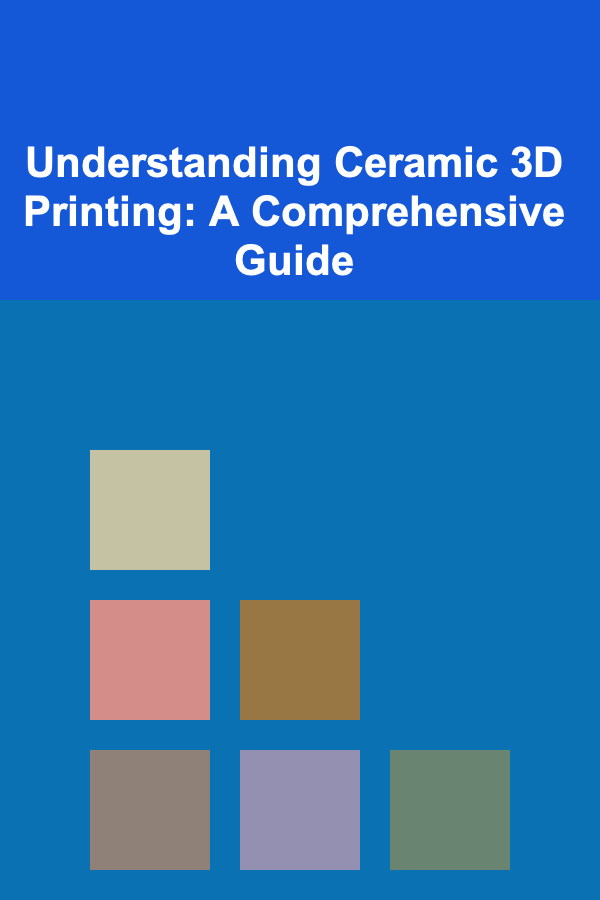
Understanding Ceramic 3D Printing: A Comprehensive Guide
ebook include PDF & Audio bundle (Micro Guide)
$12.99$9.99
Limited Time Offer! Order within the next:

Introduction: The Rise of Additive Manufacturing in Ceramics
Ceramic 3D printing, also known as additive manufacturing (AM) for ceramics, has emerged as a transformative technology, revolutionizing the way we design and produce ceramic components. While traditional ceramic manufacturing processes, such as slip casting, pressing, and extrusion, have long been the standard, they often face limitations in terms of geometric complexity, customization, and material efficiency. Ceramic 3D printing overcomes these constraints, offering unprecedented design freedom, rapid prototyping capabilities, and the potential for mass customization. This article delves into the intricacies of ceramic 3D printing, exploring the various technologies, materials, applications, and challenges associated with this exciting field.
From intricate biomedical implants to high-performance aerospace components, the potential applications of ceramic 3D printing are vast and constantly expanding. This guide aims to provide a comprehensive understanding of this rapidly evolving technology, equipping readers with the knowledge necessary to navigate the landscape of ceramic 3D printing and appreciate its potential impact across diverse industries.
Why Ceramics for 3D Printing? Understanding the Material Advantages
Ceramics, a broad class of inorganic, non-metallic materials, possess a unique combination of properties that make them highly desirable for a wide range of applications. These properties include:
- High Hardness and Wear Resistance: Ceramics are exceptionally resistant to abrasion and wear, making them ideal for applications involving friction and high stress.
- High Temperature Resistance: Many ceramics can withstand extremely high temperatures without significant degradation, making them suitable for aerospace, automotive, and energy applications.
- Chemical Inertness: Ceramics are generally chemically inert, resisting corrosion and degradation in harsh environments.
- Electrical Insulation: Many ceramics are excellent electrical insulators, making them useful in electronic components and high-voltage applications.
- Biocompatibility: Certain ceramics, such as alumina and zirconia, are biocompatible and can be used in biomedical implants.
These inherent properties, combined with the design freedom offered by 3D printing, unlock new possibilities for creating complex ceramic components with tailored performance characteristics. This is particularly valuable in applications where traditional manufacturing methods struggle to meet the demands of intricate geometries or specific material requirements.
Ceramic 3D Printing Technologies: A Detailed Overview
Several 3D printing technologies have been adapted for processing ceramic materials. Each technology offers its own advantages and limitations in terms of material compatibility, print resolution, build volume, and cost. Here's a breakdown of the most prevalent ceramic 3D printing methods:
3.1 Stereolithography (SLA)
Stereolithography (SLA) is one of the earliest and most established 3D printing technologies. In ceramic SLA, a liquid resin containing dispersed ceramic particles is selectively cured by a UV laser. The laser traces the cross-sectional geometry of each layer, solidifying the resin. After each layer is printed, the build platform moves down, and the process is repeated until the entire part is fabricated. The green part (the printed part before firing) then undergoes a debinding process to remove the polymer binder, followed by sintering to densify the ceramic material.
Advantages: High resolution, smooth surface finish, capable of producing intricate geometries.
Disadvantages: Limited material selection (typically requires specialized ceramic-filled resins), can be expensive.
3.2 Digital Light Processing (DLP)
Digital Light Processing (DLP) is similar to SLA, but instead of using a laser, it uses a projector to cure an entire layer of resin at once. This can significantly speed up the printing process, especially for parts with large cross-sectional areas. The subsequent debinding and sintering steps are the same as in SLA.
Advantages: Faster printing speeds compared to SLA, good resolution, suitable for batch production.
Disadvantages: Similar material limitations to SLA, can be more expensive than some other technologies.
3.3 Fused Deposition Modeling (FDM) or Fused Filament Fabrication (FFF)
Fused Deposition Modeling (FDM), also known as Fused Filament Fabrication (FFF), involves extruding a thermoplastic filament containing ceramic particles through a heated nozzle. The nozzle moves according to a pre-programmed path, depositing the material layer by layer to build the part. After printing, the part undergoes debinding and sintering to remove the polymer binder and densify the ceramic.
Advantages: Relatively low cost, wide availability of printers, can process a range of ceramic-filled filaments.
Disadvantages: Lower resolution compared to SLA and DLP, potential for warping and layer adhesion issues, longer print times.
3.4 Selective Laser Sintering (SLS)
Selective Laser Sintering (SLS) uses a laser to selectively fuse ceramic powder particles together. A thin layer of powder is spread across a build platform, and the laser traces the cross-sectional geometry of each layer, sintering the powder particles together. After each layer, the build platform lowers, and a new layer of powder is spread. This process is repeated until the entire part is built. Unlike SLA, DLP, and FDM, SLS typically does not require a separate debinding step because it doesn't heavily rely on binders.
Advantages: Can process a wider range of ceramic materials in powder form, no support structures needed, good mechanical properties.
Disadvantages: Surface finish can be rough, dimensional accuracy may be lower than SLA/DLP, can be expensive.
3.5 Binder Jetting
Binder Jetting involves depositing a liquid binder onto a bed of ceramic powder particles. The binder selectively bonds the powder particles together, forming the shape of the part layer by layer. After printing, the green part is carefully removed from the powder bed and then sintered to achieve full density. Binder jetting often requires an infiltration step where another material is infused to improve the density and strength of the part before sintering.
Advantages: High printing speeds, large build volumes, relatively low cost per part, can process a wide range of ceramic powders.
Disadvantages: Lower strength and density in the green part, requires careful handling during post-processing, may require infiltration to achieve desired properties.
3.6 Material Jetting
Material jetting involves jetting droplets of a liquid photopolymer containing ceramic particles onto a build platform. The droplets are then cured by UV light. This process is repeated layer by layer until the final part is created. Support structures are typically printed using a different material and are removed after printing. This technology allows for multi-material printing, creating parts with varying ceramic compositions or integrating ceramics with other materials.
Advantages: High resolution, multi-material printing capabilities, excellent surface finish.
Disadvantages: Limited material selection, relatively high cost.
Materials Used in Ceramic 3D Printing: From Traditional to Advanced
The range of ceramic materials that can be processed using 3D printing is continually expanding. While traditional ceramics like alumina, zirconia, and silica are commonly used, researchers are also exploring the use of more advanced ceramics and composites. Here's an overview of some of the key materials used in ceramic 3D printing:
4.1 Alumina (Aluminum Oxide, Al~2~O~3~)
Alumina is one of the most widely used technical ceramics. It offers excellent hardness, wear resistance, electrical insulation, and chemical inertness. It is commonly used in applications such as cutting tools, wear parts, electrical insulators, and biomedical implants.
4.2 Zirconia (Zirconium Dioxide, ZrO~2~)
Zirconia is known for its high strength, toughness, and thermal stability. It also exhibits good biocompatibility, making it suitable for dental implants, hip replacements, and other biomedical applications. Partially stabilized zirconia (PSZ) is often used to improve its toughness.
4.3 Silica (Silicon Dioxide, SiO~2~)
Silica is a common component of glass and is also used in various ceramic applications. It has good chemical resistance and electrical insulation properties. Fused silica is particularly useful for high-temperature applications.
4.4 Silicon Carbide (SiC)
Silicon carbide is an extremely hard and wear-resistant ceramic. It also has excellent high-temperature strength and thermal conductivity. SiC is commonly used in abrasives, cutting tools, heat exchangers, and high-performance brakes.
4.5 Silicon Nitride (Si~3~N~4~)
Silicon nitride offers high strength, toughness, and thermal shock resistance. It is used in demanding applications such as engine components, bearings, and cutting tools.
4.6 Hydroxyapatite (HA)
Hydroxyapatite is a calcium phosphate ceramic that is the main mineral component of bone. It is highly biocompatible and osteoconductive, making it ideal for bone grafts, bone scaffolds, and dental implants.
4.7 Bioglass
Bioglass is a bioactive glass that forms a strong bond with bone tissue. It is used in bone regeneration applications and can stimulate bone growth.
4.8 Composites
Ceramic matrix composites (CMCs) combine ceramic materials with other materials, such as fibers or metals, to enhance their properties. For example, carbon fiber reinforced silicon carbide (C/SiC) offers high strength and toughness at high temperatures and is used in aerospace applications. 3D printing of CMCs is still a developing area.
The Ceramic 3D Printing Workflow: From Design to Finished Part
The ceramic 3D printing workflow typically involves the following steps:
5.1 Design and Modeling
The first step is to create a 3D model of the desired ceramic part using computer-aided design (CAD) software. The design must consider the limitations of the chosen 3D printing technology and the properties of the ceramic material. Factors such as support structure requirements, minimum feature size, and shrinkage during sintering need to be taken into account.
5.2 Material Preparation
The ceramic material needs to be prepared in a form suitable for the chosen 3D printing technology. This may involve mixing ceramic powder with a binder to create a slurry or paste for SLA/DLP, or creating a ceramic-filled filament for FDM. For SLS and binder jetting, the ceramic powder needs to be carefully selected and characterized to ensure optimal sintering behavior.
5.3 3D Printing
The prepared ceramic material is then fed into the 3D printer, and the part is built layer by layer according to the pre-programmed design. The printing parameters, such as layer thickness, laser power, scanning speed, and build platform temperature, need to be carefully optimized to achieve the desired part quality and dimensional accuracy.
5.4 Debinding (if applicable)
For technologies that use binders (SLA, DLP, FDM, binder jetting), the green part needs to be debinded to remove the polymer binder. This is typically done by heating the part in a controlled atmosphere, allowing the binder to decompose and evaporate. The debinding process must be carefully controlled to prevent cracking or distortion of the part.
5.5 Sintering
Sintering is a crucial step in ceramic 3D printing. It involves heating the debinded or printed part to a high temperature, typically close to the melting point of the ceramic material. This causes the ceramic particles to fuse together, densifying the material and increasing its strength and hardness. The sintering process also causes the part to shrink, which needs to be accounted for during the design phase. Sintering atmosphere, temperature, and holding time are all critical parameters that affect the final properties of the ceramic part.
5.6 Post-Processing (optional)
Depending on the application, the sintered ceramic part may require additional post-processing steps, such as machining, grinding, polishing, or coating. These steps can improve the surface finish, dimensional accuracy, and functional properties of the part.
Applications of Ceramic 3D Printing: A Diverse Range of Industries
Ceramic 3D printing is finding applications in a wide range of industries, including:
6.1 Biomedical
Ceramic 3D printing is used to create custom-designed implants, bone scaffolds, dental crowns, and drug delivery devices. The biocompatibility and osteoconductivity of ceramics like hydroxyapatite and zirconia make them ideal for these applications. The ability to create porous structures with controlled pore size and interconnectivity is particularly valuable for bone regeneration.
6.2 Aerospace
Ceramic 3D printing is used to produce high-temperature components for jet engines, thermal protection systems, and rocket nozzles. Ceramics like silicon carbide and silicon nitride offer excellent high-temperature strength and thermal shock resistance, making them suitable for these demanding applications. Ceramic matrix composites are also being explored for aerospace applications.
6.3 Automotive
Ceramic 3D printing is used to create wear-resistant components for engines, brakes, and exhaust systems. Ceramics like alumina and silicon carbide offer excellent hardness and wear resistance, extending the lifespan of these components. Ceramic 3D printing can also be used to create lightweight components to improve fuel efficiency.
6.4 Electronics
Ceramic 3D printing is used to produce electrical insulators, substrates for electronic circuits, and components for sensors and actuators. Ceramics like alumina and silica offer excellent electrical insulation properties. 3D printing allows for the creation of complex geometries and the integration of multiple materials in electronic devices.
6.5 Tooling and Manufacturing
Ceramic 3D printing is used to create molds, dies, and cutting tools. Ceramics like alumina and silicon carbide offer high hardness and wear resistance, making them suitable for these applications. 3D printing allows for the creation of complex tooling geometries that are difficult to produce using traditional methods.
6.6 Art and Design
Ceramic 3D printing is being used by artists and designers to create intricate and complex ceramic sculptures, jewelry, and tableware. 3D printing offers unprecedented design freedom, allowing artists to explore new forms and patterns that are impossible to achieve with traditional ceramic techniques.
6.7 Chemical Engineering
Ceramic 3D printing can be used to create custom catalyst supports, microreactors, and other specialized components for chemical processing. The ability to tailor the porosity and surface area of the ceramic material is particularly valuable in catalyst design.
Challenges and Future Directions in Ceramic 3D Printing
While ceramic 3D printing offers significant advantages, it also faces several challenges that need to be addressed to further advance the technology. These challenges include:
7.1 Material Development
The range of ceramic materials that can be processed using 3D printing is still limited. Further research is needed to develop new ceramic formulations and materials that are specifically tailored for 3D printing processes. This includes developing materials with improved printability, sinterability, and mechanical properties.
7.2 Process Optimization
The 3D printing process parameters, such as layer thickness, laser power, scanning speed, and build platform temperature, need to be carefully optimized for each material and printing technology. More research is needed to develop automated process control systems that can ensure consistent and reliable printing results.
7.3 Dimensional Accuracy and Surface Finish
Achieving high dimensional accuracy and smooth surface finish in ceramic 3D printed parts can be challenging. Shrinkage during sintering and the layer-by-layer nature of the printing process can lead to deviations from the designed geometry and surface imperfections. Further research is needed to develop techniques for minimizing shrinkage and improving surface finish.
7.4 Cost Reduction
Ceramic 3D printing can be expensive, especially for small production runs. Reducing the cost of materials, printers, and post-processing steps is crucial for making ceramic 3D printing more accessible and competitive with traditional manufacturing methods.
7.5 Standardization
The lack of industry standards for ceramic 3D printing can make it difficult to compare different technologies and materials. Developing standards for material characterization, process control, and part quality is essential for promoting the adoption of ceramic 3D printing.
Despite these challenges, the future of ceramic 3D printing is bright. Ongoing research and development efforts are focused on addressing these challenges and expanding the capabilities of the technology. The following are some key areas of future development:
- Multi-material printing: Developing techniques for printing parts with multiple ceramic materials or integrating ceramics with other materials, such as metals or polymers.
- In-situ monitoring and control: Integrating sensors and control systems into 3D printers to monitor and adjust the printing process in real-time, improving part quality and reducing waste.
- Artificial intelligence and machine learning: Using AI and machine learning to optimize printing parameters, predict part properties, and automate the design and manufacturing process.
- Scaling up production: Developing techniques for scaling up ceramic 3D printing to enable mass production of ceramic components.
As these advancements continue, ceramic 3D printing is poised to play an increasingly important role in a wide range of industries, enabling the creation of innovative products with enhanced performance and functionality.
Conclusion: The Transformative Potential of Ceramic 3D Printing
Ceramic 3D printing represents a significant advancement in ceramic manufacturing, offering unprecedented design freedom, rapid prototyping capabilities, and the potential for mass customization. While challenges remain, ongoing research and development efforts are paving the way for a future where ceramic 3D printing is a mainstream manufacturing technology. From biomedical implants to aerospace components, the applications of ceramic 3D printing are vast and continue to expand, promising to revolutionize the way we design and produce ceramic parts for a wide range of industries. Understanding the principles, technologies, materials, and challenges associated with ceramic 3D printing is essential for anyone seeking to leverage the transformative potential of this exciting technology.

How to Organize Your Kitchen for Maximum Space Efficiency
Read More
How To Understand the Physical Demands of Esports
Read More
How to Get ChatGPT to Generate Sports News Reports
Read More
Understanding Trick-Taking Card Games: A Deep Dive
Read More
Protecting Your Garden from Critters: A Comprehensive Guide
Read More
10 Tips for a Career Development Checklist Focused on Soft Skills
Read MoreOther Products

How to Organize Your Kitchen for Maximum Space Efficiency
Read More
How To Understand the Physical Demands of Esports
Read More
How to Get ChatGPT to Generate Sports News Reports
Read More
Understanding Trick-Taking Card Games: A Deep Dive
Read More
Protecting Your Garden from Critters: A Comprehensive Guide
Read More